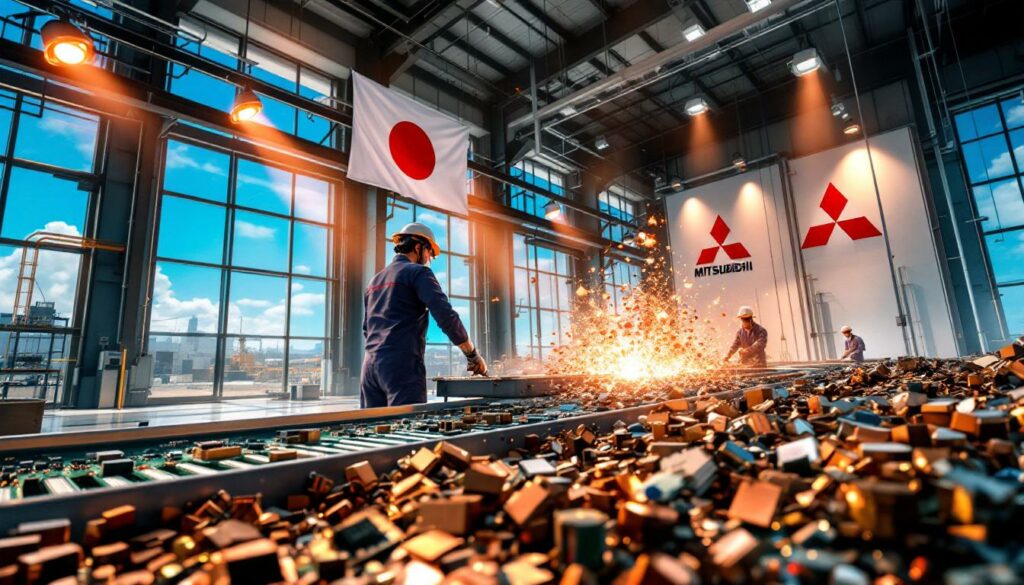The Strategic Evolution of Mitsubishi Materials' Copper Processing Approach
In a significant shift for the metals industry, Mitsubishi Materials Corporation has announced plans to scale down its copper concentrate processing operations at its Onahama facility in Fukushima Prefecture. This strategic realignment comes amid challenging market conditions that have created substantial headwinds for traditional copper smelting businesses worldwide.
The Japanese metals producer is pivoting toward a more sustainable business model by increasing its focus on recycled materials while reducing dependence on conventional copper concentrate processing. This transition reflects broader industry challenges and signals potential shifts in how major metals companies approach resource processing in the future.
Navigating Challenges in Copper Concentrate Processing
The decision to scale down operations at the Onahama Smelting and Refining facility represents a strategic response to deteriorating market conditions. According to Mitsubishi Materials' recent announcement, the company faces a "significant downturn in the external environment for its copper production forecast business, particularly with TC/RC for copper concentrates," as reported by Mining Technology in August 2025.
Treatment charges and refining charges (TC/RC) represent fees that mining companies pay to smelters for processing copper concentrate into refined copper. These rates fluctuate based on market conditions and significantly impact smelter profitability. When TC/RC rates decline, smelting operations become less profitable, forcing companies to reconsider their operational strategies.
The company has identified several critical factors necessitating this operational shift:
- Deteriorating treatment charges and refining charges (TC/RC) for copper concentrates
- Uncertain outlook for the conventional smelting business model
- Projected decline in profitability for concentrate-based processing
- Need to enhance overall business sustainability through alternative approaches
Implementation Timeline and Approach
Rather than a complete shutdown, Mitsubishi Materials plans to "partly halt production facilities" at the Onahama site following scheduled maintenance between October and November 2025. This measured approach allows the company to maintain some processing capacity while reducing exposure to challenging market conditions.
The partial scale-down represents a strategic balancing act between maintaining operational capabilities and addressing financial pressures. By maintaining some concentrate processing capacity, Mitsubishi Materials preserves flexibility to respond to potential future improvements in market conditions.
The Growing Importance of Recycled Materials
While reducing its reliance on copper concentrate, Mitsubishi Materials intends to maintain consistent treatment volumes for electronic scrap (E-Scrap), including discarded electronic circuit boards and other recyclable materials. This approach aligns with the company's goal to "raise the proportion of recycled materials used" in its production processes.
Strategic Advantages of E-Scrap Processing
This pivot toward recycled materials offers several strategic advantages:
- Reduced Market Volatility: E-Scrap processing is "less impacted by TC/RC fluctuations" that affect concentrate processing
- Supply Chain Diversification: Decreased dependence on mining outputs creates more resilient raw material sourcing
- Sustainability Benefits: Enhanced environmental credentials through participation in circular economy initiatives
- Economic Opportunity: Potential for improved margins through higher-value recycled material streams
The Economics of Recycling vs. Traditional Processing
Electronic waste contains significantly higher concentrations of copper and precious metals compared to typical mined ores. While primary copper ores might contain 0.5-1% copper, electronic components can contain 20-30% copper by weight, along with gold, silver, and palladium in concentrations that make recovery economically attractive.
This concentration differential creates a compelling economic case for recycling, particularly when traditional concentrate processing faces margin pressures from declining TC/RC rates.
Industry Insight: The copper recycling market benefits from dual economic drivers—lower processing costs compared to primary extraction and potential recovery of multiple valuable metals from a single waste stream.
Technological Considerations
Processing E-Scrap requires different technological approaches than conventional concentrate processing. While traditional smelting focuses on separating copper from sulfide minerals, E-Scrap processing must handle a complex mix of metals, plastics, and other materials.
Advanced sorting technologies, hydrometallurgical processes, and specialized recovery methods are increasingly important in efficiently processing electronic waste. Mitsubishi's strategic shift suggests confidence in their technological capabilities to handle these more complex but potentially more valuable material streams.
Production Facility Transformations
Mitsubishi Materials' strategic shift involves adjustments across multiple facilities, creating an integrated approach to transforming its copper processing operations.
Naoshima Smelter & Refinery Adjustments
At its Naoshima facility in Kagawa Prefecture, Mitsubishi Materials has revised its 2024 investment plan with two key objectives:
- Limiting increases in copper concentrate processing capacity
- Boosting capacity for E-Scrap processing
Despite these adjustments, the company continues to proceed with renewal and expansion of certain production facilities at the site, indicating a selective rather than wholesale transformation of operations.
The Sakai and Sambo Integration Plan
Beyond the changes at its smelting operations, Mitsubishi Materials is preparing to integrate its Sakai and Sambo plants in Osaka Prefecture by April 1, 2026. According to Mining Technology, these facilities are "closely linked within the Copper & Copper Alloy business value chain," with the Sakai Plant "casting billets and cakes for further processing at the Sambo Plant."
This integration aims to:
- Optimize production systems across both facilities
- Accelerate growth in the Copper & Copper Alloy business segment
- Enhance business agility and operational flexibility
The physical proximity of these plants has historically facilitated collaboration, but the upcoming integration will formalize and enhance this cooperation, creating a more streamlined operation with improved efficiency and responsiveness.
Anticipated Benefits of the Strategic Realignment
Mitsubishi Materials expects several significant benefits from its multi-faceted strategic shift.
Operational Improvements
The company anticipates substantial operational enhancements, including:
- Enhanced Manufacturing Efficiency: Integration of facilities will streamline production flows
- Reduced Production Lead Times: More coordinated operations across the value chain
- Improved Business Agility: Better responsiveness to market changes and customer needs
- Optimized Resource Utilization: More effective deployment of equipment, expertise, and capital
According to the company's statement, these initiatives will "strengthen the integrated production system from casting to processing," creating a more cohesive operational structure.
Financial Considerations
While specific financial projections haven't been disclosed, the strategic shift appears designed to address profitability concerns through:
- Reduced Market Exposure: Less vulnerability to volatile TC/RC rates
- Higher-Margin Operations: Focus on potentially more profitable recycled material processing
- Operational Efficiencies: Cost savings through facility integration and optimization
- Long-Term Sustainability: Creation of a business model less dependent on increasingly challenging concentrate markets
By restructuring its operations now, Mitsubishi Materials aims to position itself for sustainable profitability even if traditional smelting economics continue to deteriorate.
Broader Industry Context and Implications
Mitsubishi Materials' strategic pivot should be understood within the context of broader trends affecting the global copper processing industry.
Evolving Economics of Copper Processing
The traditional copper smelting model faces multiple challenges:
- Margin Pressure: Declining TC/RC rates squeeze profitability for conventional smelters
- Rising Costs: Energy, labor, and regulatory compliance expenses continue to increase
- Competitive Landscape: Growing competition from lower-cost producers in developing markets
- Supply Chain Complexity: Increasing challenges in securing consistent concentrate supplies
These factors collectively undermine the conventional smelting business model and drive innovation in alternative approaches, including increased focus on recycled materials.
Sustainability Considerations
The enhanced focus on recycled materials aligns with global sustainability trends and offers significant environmental benefits:
- Energy Efficiency: Recycling copper typically requires 85-90% less energy than primary production
- Carbon Footprint Reduction: Lower energy requirements translate to reduced greenhouse gas emissions
- Resource Conservation: Less reliance on extractive mining operations
- Waste Reduction: Diversion of electronic waste from landfills to productive reuse
These environmental advantages complement the economic rationale for Mitsubishi Materials' strategic shift, creating a business case aligned with broader societal priorities.
Key Questions About Mitsubishi's Strategic Direction
Despite the detailed announcement, several important questions remain about Mitsubishi Materials' strategic shift.
Workforce Implications
The company's announcement doesn't address potential impacts on employment at affected facilities. Key questions include:
- Will the operational changes result in workforce reductions?
- How might employees be redeployed from concentrate processing to recycling operations?
- What training or transition programs might be implemented to facilitate this shift?
These workforce considerations represent an important dimension of the strategic shift that remains to be clarified.
Supply Chain Impacts
The pivot also raises questions about effects throughout Mitsubishi Materials' supply chain:
- How will mining partners that currently supply concentrate be affected?
- What new supplier relationships might be needed for recycled materials?
- Could this shift influence pricing or availability of copper concentrates in regional markets?
These ripple effects could have significant implications beyond Mitsubishi Materials' own operations.
Industry Signaling
As a major player in Japan's metals industry, Mitsubishi Materials' strategic shift may signal broader changes:
- Will other Japanese metals processors follow similar strategic paths?
- Does this represent an inflection point in the economics of traditional copper smelting?
- How might mining companies adjust their strategies if more smelters reduce concentrate processing?
The answers to these questions will emerge over time as the industry responds to both Mitsubishi Materials' shift and the underlying market conditions driving it.
Understanding Key Aspects of Copper Processing
To fully grasp the significance of Mitsubishi Materials' strategic shift, it's helpful to understand several fundamental aspects of copper processing.
What is TC/RC and Why Does It Matter?
Treatment charges and refining charges (TC/RC) represent the fees that mining companies pay to smelters for processing copper concentrate into refined copper. These rates are typically negotiated annually but can also be set on spot markets for individual shipments.
TC/RC rates fluctuate based on:
- Market Balance: Supply and demand for processing capacity
- Concentrate Quality: Lower-quality concentrates typically incur higher charges
- Geographic Factors: Regional processing capacity and transportation costs
- Energy Costs: Processing expenses influence sustainable TC/RC rates
When TC/RC rates decline, smelter profitability suffers, potentially to the point where processing becomes uneconomical without operational changes.
E-Scrap Processing vs. Concentrate Processing
These two approaches to copper production differ significantly in multiple dimensions:
| Aspect | Concentrate Processing | E-Scrap Processing |
|---|---|---|
| Raw Material Source | Mining operations | Electronic waste collection |
| Copper Content | Typically 20-30% | Varies widely (5-40%) |
| Processing Method | Pyrometallurgical smelting | Combined physical separation and metallurgical processing |
| By-Products | Primarily sulfuric acid | Precious metals, other base metals |
| Market Dynamics | Subject to TC/RC fluctuations | Relatively stable processing economics |
| Environmental Impact | Higher energy use and emissions | Lower energy use and emissions |
These differences explain why companies like Mitsubishi Materials might pivot toward recycling when traditional smelting economics deteriorate.
The Circular Economy Connection
The increased focus on E-Scrap processing represents a shift toward circular economy principles in metals production. Rather than the traditional linear model (extract → process → use → dispose), circular approaches prioritize keeping materials in productive use through multiple cycles.
For copper specifically, recycling offers significant advantages:
- Copper can be recycled indefinitely without loss of properties
- Recycled copper requires only a fraction of the energy needed for primary production
- Recovery from complex waste streams is increasingly economical with advanced technologies
Mitsubishi Materials' strategic shift aligns with this circular economy approach, potentially positioning the company advantageously as sustainability pressures increase.
Future Outlook for Copper Processing
While specific predictions remain challenging, Mitsubishi Materials' strategic shift offers several insights into potential future directions for copper processing.
Emerging Trends to Watch
The copper processing industry appears likely to experience several important trends:
- Recycling Growth: Increased focus on recycled materials across the industry
- Technological Innovation: Accelerated development of more efficient recovery technologies
- Integration Patterns: More companies integrating across processing stages
- Regional Shifts: Potential realignment of processing capacity toward regions with favorable economics
These trends suggest a period of significant transformation for an industry that has historically changed relatively slowly.
Implications for Stakeholders
Different stakeholders will experience varying impacts from these industry shifts:
- Mining Companies: May face challenges in placing concentrates if more smelters reduce processing
- Recycling Enterprises: Could see growing demand and improved economics
- End Users: Might benefit from more sustainable supply chains but face potential copper price insights and fluctuations
- Policymakers: Will need to consider implications for resource security and environmental regulation
Disclaimer: The copper industry remains subject to significant market uncertainties, including macroeconomic factors, technological developments, and regulatory changes. This analysis represents an assessment based on current information rather than definitive predictions.
Conclusion: A Strategic Inflection Point
Mitsubishi Materials' decision to scale down copper concentrate processing while maintaining E-Scrap processing volumes represents more than a simple operational adjustment. It signals a potential inflection point in how major metals producers approach copper processing in response to changing market dynamics.
By integrating facilities, optimizing production systems, and shifting toward recycled materials, the company aims to create a more sustainable business model less vulnerable to volatile TC/RC rates. This approach balances immediate profitability concerns with longer-term positioning in an evolving industry landscape.
As other copper processors evaluate similar challenges, Mitsubishi Materials' strategic pivot may prove instructive. The company's approach—measured reduction rather than wholesale abandonment of concentrate processing, combined with facility integration and increased recycling focus—offers a template for adaptation that other industry players may consider as they navigate their own strategic futures. Furthermore, the industry will likely see continued innovation in mine reclamation innovations and gold-copper exploration as copper investment trends evolve in response to these market shifts.
Want to Profit from the Next Major Mineral Discovery?
Discovery Alert's proprietary Discovery IQ model provides real-time notifications on significant ASX mineral discoveries, transforming complex data into actionable investment opportunities. Explore why historic discoveries have generated substantial returns by visiting the Discovery Alert discoveries page and position yourself ahead of the market.




